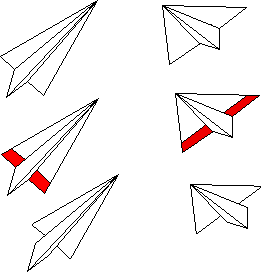Flyin' Planes
Airplanes are fun. Airplanes
are one of the ways people travel around the world. The following are
activities that explain how airplanes and lift work. The science of airplanes
and balloons is called aerodynamics. Below are the parts of an airplane. Each of these
parts has a role to play in an airplane. The Cubs can discover how many of these parts work to
lift an airplane off the ground, travel in the sky and safely bring it back down
to earth.

| AIRPLANE |
An airplane
is a vehicle heavier than air, powered by an engine, which travels
through the air by the reaction of air passing over its wings. |
| FUSELAGE |
The fuselage is the
central body portion of an airplane which accommodates the crew and
passengers or cargo. |
| COCKPIT |
The cockpit
is usually the space in the fuselage for the pilot and the passengers:
in some aircrafts it is just the pilot's compartment. |
| LANDING GEAR |
The landing gear, located
underneath the airplane, supports it while on the ground. |
| WINGS |
The wings are the parts of
airplanes which provide lift and support the entire weight of the
aircraft and its contents while in flight. |
| PROPELLER |
A propeller is a rotating
blade located on the front of the airplane. The engine turns the
propeller which most often pulls the airplane through the air.
Many airplanes use jet engines. |
| FLAPS |
The flaps are the movable
sections of an airplane's wings closest to the fuselage. They are moved
in the same direction (down) and enable the airplane to fly more slowly
and help it take off (flaps up) and land (flaps down). |
| AILERONS |
Ailerons are the outward
movable sections of an airplane's wings which move in opposite
directions (one up, one down). They are used in making left and right
banking turns. |
| RUDDER |
The rudder is the movable
vertical section of the tail which controls lateral movement left and
right. |
| HORIZONTAL |
The horizontal stabilizer
is the horizontal surface of the aft part of the fuselage used to
balance the airplane. |
| ELEVATOR |
The elevator is the
movable horizontal section of the tail which causes the plane to move up
and down. |
 Activity
1. Build and Fly an Airplane
Activity
1. Build and Fly an Airplane
 Give Cubs a sheet of unlined paper and instructions for construction of a
paper airplane
Give Cubs a sheet of unlined paper and instructions for construction of a
paper airplane
 Cubs
should give their plane a name using
the aviation alphabet. (Example N 831 FE represents November 831 Foxtrot
Echo.
Cubs
should give their plane a name using
the aviation alphabet. (Example N 831 FE represents November 831 Foxtrot
Echo.
 Have
the Cubs build the plane, draw on them and have flight tests to try them
out. The Sixes can have competitions such as:
Have
the Cubs build the plane, draw on them and have flight tests to try them
out. The Sixes can have competitions such as:
- Longest distance
- Most time in the air
- Most accurate when thrown through a hoop
- Flying highest
- Best design or coloration
 Have
the Cubs build a duplicate plane. Cut slots on where the ailerons are
and see what happens when the the ailerons up, down or opposite. Build
the paper plane with a rudder and see what happens when these are
moved to the left or right. Cut off the ailerons (shown in red) and
see how high the plane will fly opposite the duplicate.
Have
the Cubs build a duplicate plane. Cut slots on where the ailerons are
and see what happens when the the ailerons up, down or opposite. Build
the paper plane with a rudder and see what happens when these are
moved to the left or right. Cut off the ailerons (shown in red) and
see how high the plane will fly opposite the duplicate.
 Discuss the results from
the flight tests.
Discuss the results from
the flight tests.
ADDITIONAL QUESTION: "Why don't all
planes have the biggest wing area possible? Why do some fighter jets have
small wings?" (ANSWER: There are other factors that contribute to lift,
such as velocity and shape of the wing)
Activity 2: Build and Fly a Hot Air
Balloon

 MATERIALS:
MATERIALS:
- Dry cleaner plastic film bags (select a bag with the thinnest possible
plastic and have several on hand. You may have to experiment with bags of
different thicknesses.)
- Several small paper clips
- Cellophane tape
- Heat source (Blow dryer, sterno, backpacker camp stove, etc.)
Matches
- Three feet of aluminum heat duct (if using open flame heat source)
-Electric drill (to put holes in the heat duct)
 PROCEDURE:
PROCEDURE:
- Seal any openings and tears in the upperr end of the bag with a minimum of
cellophane tape.
- Attach several paper clips to the plastic around the lower opening. The
number of paper clips to attach is determined by experimentation.
- If using sterno or some other openn flame heat source, prepare the heat
duct by drilling several holes around the base to allow air to flow in.
- Turn on the blow dryer (or light tthe Sterno or stove and then set the
heat duct over it) Spread the bag opening wide to capture the rising hot air
while supporting the upper end with your hand. It is best to have assistance
in keeping the bag open so that it does not melt.
- When the bag is inflated with hot air, test its buoyancy by letting it go
for a moment. If it rises quickly, stand back and let it fly otherwise
continue heating it for a little while longer.
-If the bag tips over and spills its hot air before it reaches the
ceiling, add a few more paper clips to weigh down the bottom slightly. If
the bag will not rise at all, remove a few clips.
 CAUTION: Be careful not to brush clothes or fingers into the flames or
touch the metal heat duct. Keep a fire extinguisher handy if you use flames.
If the bag starts to crumple and melt from the heat, set the blow dryer on a
lower setting or hold the bag farther from the heat source.
CAUTION: Be careful not to brush clothes or fingers into the flames or
touch the metal heat duct. Keep a fire extinguisher handy if you use flames.
If the bag starts to crumple and melt from the heat, set the blow dryer on a
lower setting or hold the bag farther from the heat source.
 DISCUSSION:
Hot air is less dense than cold air. Heat accelerates the motion of the air
molecules causing fewer molecules to occupy the same space as a much greater
number of molecules do at a lower temperature. With fewer molecules, the hot
air has less mass, and therefore is buoyant than an equal volume of colder
air.
DISCUSSION:
Hot air is less dense than cold air. Heat accelerates the motion of the air
molecules causing fewer molecules to occupy the same space as a much greater
number of molecules do at a lower temperature. With fewer molecules, the hot
air has less mass, and therefore is buoyant than an equal volume of colder
air.
Placing the dry cleaner
bag over the heat source captures the hot air and forces out the cooler air in
the bag. The bag becomes a mass of low-density air which floats up-ward in the higher denser air surrounding it. The paper clips are placed at
the bottom of the bag to keep the open end downward in flight to prevent it
from prematurely spilling the hot air and terminating the flight.
This material can be used to fulfill partial requirements for
the Purple Star and the Individual
Speciality Badge.